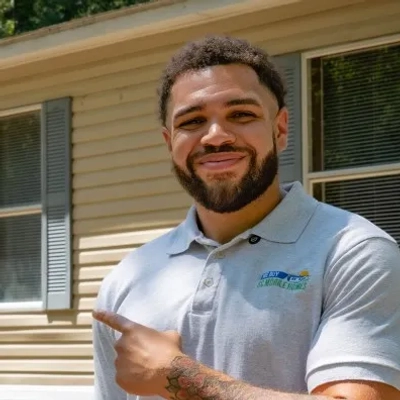25 Negotiation Techniques for Reaching Favorable Contract Terms
This comprehensive guide brings together battle-tested negotiation techniques with expert insights from seasoned contract negotiators across industries. The article examines 25 proven methods for securing favorable terms, from strategic anchoring to effective communication approaches that build lasting business relationships. Each technique has been carefully selected to provide practical strategies that readers can immediately apply to their own negotiation scenarios.
Frame Relationships Above Individual Deals
One negotiation move that's helped me time and again is framing the relationship as more important than the single deal. For example, when buying a duplex, I reminded the seller how smooth past sales led to referrals for other properties, and their guard came down quickly. Look, tough negotiations can stall fast, but focusing on future opportunities softens the tension every single time.

Bundle Services to Boost Perceived Value
One technique I lean on is bundling services together because it boosts the perceived value for clients while still maintaining strong margins. For example, when agencies wanted only link building, I'd suggest pairing it with content or blogger outreach, which often led to less pushback on price and a smoother close. My take: reach for bundled services whenever negotiations start stalling, as it shifts the focus to overall impact instead of line-by-line costs.

Anchor with Clear Priorities First
One negotiation technique I rely on is anchoring with clear priorities before entering the discussion. After years in SaaS, I've seen that if I outline the two or three non-negotiable points first, it prevents us from wasting time circling around minor issues. For example, in a partnership deal, I once started by openly stating that integration flexibility was the top priority, while other terms had room for adjustment. This shifted the conversation toward solutions instead of back-and-forth haggling. I'd suggest always clarifying what truly matters upfrontit disarms tension and makes difficult talks more productive.

Structure Negotiations as Progressive Win Scenarios
One technique I often rely on is structuring negotiations like a game, where each side can earn small 'wins' along the way. Instead of pushing for everything upfront, I break contract terms into milestones that build momentum and let the other party feel progress. Lately, I've seen that approach reduce tension even in tough deals, because it keeps the conversation feeling collaborative rather than adversarial. Bottom line: if both sides feel engaged in the process, it's much easier to land on terms that stick.
Use Active Listening and Thoughtful Reflection
One approach I consistently use is active listening paired with reflection. In tough conversationslike negotiating service agreements or staff policiesI'll pause to restate the other party's needs in my own words before presenting my terms. This small action often lowers defenses and shows I value their perspective. I remember one contract discussion where just acknowledging the concern about costs helped us move toward a flexible timeline instead of getting stuck. My advice is simple: people often move faster toward agreement when they feel deeply heard.

Create Psychological Space by Addressing Hesitations
One negotiation technique I consistently rely on is creating psychological space by directly addressing hesitations. When negotiations reach a difficult point, I pause and genuinely ask the other party about their concerns, while clearly communicating that I'm prepared to walk away if the partnership isn't the right fit for both sides. This approach shifts the dynamic from pressure to honest evaluation, and I've found that demonstrating this willingness to step back often strengthens the other party's desire to move forward with favorable terms.
Ground Negotiations in Comparable Market Data
In franchise deals, I've found that anchoring negotiations with market data on comparable franchise fees sets a strong position early. When I scaled Dirty Dough, several landlords tried to push for higher rates until I showed comps from similar high-traffic locations. My takeaway is to keep negotiations grounded in factsit leaves less room for emotion and more for progress.
Share Real Success Stories for Trust
One technique I lean on is being upfront about our process and sharing real stories of how we've helped others in similar situations. For example, when negotiating with someone overwhelmed by repairs, I show before-and-after photos of homes we've purchased "as-is," which builds trust and shows we're genuinely here to make the process smoother. In tough negotiations, this transparency helps break the ice and keeps everyone focused on solving the problem together, rather than digging in their heels.
Anchor with Value, Not Just Numbers
Please find my answer below:
As a PR agent and talent manager, I regularly negotiate endorsement deals, brand partnerships, and performance contracts for celebrities, music acts, and TV personalities. One negotiation technique that consistently delivers favorable terms is "anchoring with value", not just numbers.
Instead of starting the discussion around "how much," I first establish why my client is worth that figure (or more). That means bringing data, case studies, and clear positioning to the table: audience demographics, engagement stats, previous campaign outcomes, and even softer assets like cultural relevance or press momentum. By framing the negotiation in terms of the brand's ROI and risk reduction, I anchor the conversation in value creation... not just fee extraction.
In difficult negotiations, when the other side pushes back or tries to undercut, I return to that anchor. For example, if a brand says, "We can't go above X," I'll redirect: "I understand budgets are tight, but let's look at the exposure and sales uplift your competitors achieved working with similar talent, and the cost of not being in this space right now."
This reframes the deal as an opportunity cost for them, rather than a concession from us.
Another technique I use - and one that applies to virtually any contract - is knowing your "walk-away point" (BATNA: Best Alternative To a Negotiated Agreement). Before I go into a negotiation, I'm crystal clear on the minimum terms that are acceptable and the alternatives available if the deal doesn't go through. This clarity gives me leverage and confidence. If the other side senses you "need" the deal at any cost, you lose bargaining power. But when you demonstrate you have other viable options, the dynamic shifts. Ironically, being willing to walk away often brings the other side back with improved terms.
The combination of anchoring with value and knowing your BATNA creates a negotiation style that is both assertive and collaborative. It ensures my clients secure terms that reflect their true worth, while also keeping relationships professional and positive.
Kind regards,
Chrissy Johnston

Offer Benefits Beyond the Price Point
I consistently use what I call the 'benefits-beyond-price' technique in negotiations. Instead of just haggling over dollars, I identify what unique value I can offer beyond the financial terms--whether that's a flexible closing timeline, handling all paperwork, or taking the property as-is with no repairs needed. In difficult negotiations, I make it a point to listen more than I speak, allowing me to uncover the seller's true priorities. Recently, when dealing with a particularly challenging estate sale, I discovered the family's main concern was actually clearing out the property quickly, so I arranged for junk removal services as part of my offer, which immediately made my terms more attractive than higher bids.

Provide Creative Solutions to Specific Problems
My best technique is consistently focusing on offering creative solutions to an owner's particular situation, rather than just a standard offer. For instance, if an owner is facing foreclosure, I might offer a lease-back option so they can stay in their home longer while still getting their equity, which makes my offer stand out dramatically against just a cash price.

Clarify Worst-Case Scenarios Early On
One technique I rely on is bringing clarity to the 'worst-case scenario' early in the conversation. If I know a seller is nervous about getting stuck with a property or a deal falling through, I'll outline exactly what happens if things don't move forward and how they're protected. In tough negotiations, this honesty takes away some of the fear, which usually opens the door to more flexible and fair terms because they see I'm not here to trap them--I'm here to solve their problem.

Present Multiple Options Instead of One
One technique I use is what I call the 'option framing' approach--rather than presenting just one offer, I give the seller two or three clear options with different trade-offs. For example, I might show them a faster closing at one price versus a slightly higher price with a longer timeline. In tough negotiations, this shifts the dynamic from 'yes or no' to 'which choice works best for me,' which makes it easier to land terms that are fair for both sides.
Start with Brutal Honesty About Alternatives
My primary technique is to be brutally honest from the start by telling sellers that they could likely get more money on the open market if they have the time and resources to wait. When negotiations get tough, this initial transparency allows me to re-center the conversation on the true value we provide: a quick, 'as-is' closing that solves their immediate problem without hassles or uncertainties. This approach builds trust and helps them see our offer as a reliable solution for their sticky situation, rather than just a number on a page.

Ask for Their Ideal Outcome First
One approach I lean on is asking the other party what their ideal outcome looks like early in the conversation. This flips the script by making it less adversarial and more collaborative--I've found that when someone feels genuinely heard, they're more likely to meet me halfway, especially when the negotiations get tense. For example, during a recent multi-family property deal, an open discussion about long-term goals helped both sides agree on flexible payment terms that worked for everyone.

Validate Emotional Stress Before Terms
I always make it a point to validate the seller's stress upfront--especially during high-stress negotiations. I'll say something like, 'This situation with the property sounds incredibly overwhelming; I get it, we've seen it countless times.' Recently, when dealing with a widow who was facing foreclosure and inheriting debt, acknowledging the emotional weight actually revealed she needed certainty over speed, so I modified our offer with a guaranteed 30-day closing window even though she had multiple higher offers--it wasn't about the money, it was reliability. That immediate validation builds trust and shifts their mental block, making challenging negotiations pivot from skepticism to partnership almost immediately.

Emphasize Community Impact of Agreements
One technique I rely on is highlighting the community impact of our purchase, especially when dealing with manufactured homes. For example, in a recent tough negotiation with a seller who was emotionally attached to their property, I explained how our renovation would transform it into an affordable, quality home for a local family -- this shared purpose often bridges gaps and leads to mutually favorable terms.

Frame Proposals Around Shared Values
I always approach negotiations with a strategy of framing proposals around shared value rather than a zero-sum mentality. Prior to any negotiation, I will identify the major interest of the other party: cash flow, flexibility, long-term viability; I then prepare terms that I believe meet those interests while preserving the things that are important to me. For example, when I was negotiating a lease (the most common terms that I would negotiate were around basing rent on market terms and the length of the lease), I would offer the landlord a minor increase in the annual escalations on the lease terms in exchange for a shorter fixed term and a longer renewal/extension option. The lease terms made sense financially for the landlord but preserved my long-term interests. I apply this same principle in more adversarial negotiations by asking open-ended hallmark questions to uncover what could be unknown interests for the other side and then position my asks around their interests (not mine) as a solution — not simply giving ground to their ask. I find that this and other strategies fundamentally shifts negotiations from adversarial to collaborative conversations. In the end, the lesson I have learned is that the best outcomes come from mutual interests rather than brute position.
Use Local Involvement as Human Collateral
One technique that always works for me is emphasizing our local involvement as human collateral when trust is low in tough negotiations. For example, when I sensed hesitation from an overwhelmed seller during an estate sale, I said, 'We volunteer at Reno Food Bank and support youth sports teams--if we don't treat you right, where would be the place to complain?' That transparency transformed the discussion, leading to accepting our fair terms that closed in 10 days to beat probate deadlines.

Present Clear Process Plans to Eliminate Uncertainty
My military background taught me that a clear plan eliminates uncertainty, so I bring that to my negotiations. I lay out the entire process on a single sheet of paper--offer, inspection, title work, closing date--so there are no surprises. When I worked with a fellow veteran on a tight PCS timeline, walking him through this clear 'mission plan' built immediate trust and allowed us to bypass the usual back-and-forth to get a fair deal done quickly.

Start with Timeline Needs, Not Price
I use what I call the 'timeline-first' approach--I always start by asking when they need to be completely done with the property, then work backwards from there. This immediately reveals their urgency level and helps me structure an offer that prioritizes their schedule over haggling on price. When I recently negotiated with a family dealing with an inherited property they couldn't maintain, discovering they needed to wrap everything up before tax season allowed me to offer a 15-day close, which they valued more than the extra $10K another buyer was offering with a 45-day timeline.
Simplify Terms and Elevate Strategic Context
My negotiation approach is built around two moves — especially valuable when there's a power imbalance.
Step 1: Strip away the smoke and mirror - The Columbo Technique
Unacceptable clauses often hide behind vague wording, "industry standard" postures, or anesthetizing jargon. What I'm doing is to cut through this. I call it the Columbo Technique: state things in the simplest, almost naive terms, until the absurdity becomes undeniable.
Example: a clause that gives one party the unilateral right to act freely, while the other must first beg for approval — put plainly, that's a blank check. Or worse, putting the weaker party handcuffed, feet and fists tied, while the stronger side roams free. When explained in plain language, anyone in the room feels the imbalance. Simplicity kills the illusion.
Step 2: Change the playing field - The Meta Approach
Once the clause is exposed, I shift the discussion to a higher, more strategic level. This is the Meta Approach: move from a transactional debate ("do we accept this item?") to a bigger lens.
* Is this clause even consistent with regulation?
* Does it contradict competition policy, locally or at the EU level?
* How will it look if my peers start forming a coalition against it?
By reframing the negotiation, the other side suddenly faces not just me, but the risk of regulatory scrutiny, reputational backlash, and snowball effects.
The lesson: In tough negotiations, don't get trapped in the weeds. Expose the clause for what it really is — and then elevate the conversation to a level where the other side loses their footing.

Tell Stories with Numbers for Growth
A unique negotiation approach I use is storytelling with numbers. Instead of only pushing for discounts, I paint a picture of what success looks like if the supplier works with us long-term. For example, I'll show a simple forecast: by lowering price on the first 500 units, the client can scale to 5,000 within six months, meaning more stable orders for them. This turns the talk from a battle over margin into a shared growth plan. In one tough case, a supplier not only agreed to better payment terms but also offered priority production slots because they believed in the bigger story. What makes this work is combining vision with data so the other side feels like a partner, not an opponent. At SourcingXpro, that's how we keep negotiations both fair and forward-looking.

Be Realistic Upfront to Avoid Poison
Hi there,
Attorney Monelli has the following to share:
"Negotiation technique: be realistic up front. As an attorney, an observation I have about clients is that they want to start ridiculous and then get realistic. Starting ridiculous makes you look stupid to the other side and poisons the process."

Master Strategic Silence After Key Points
One negotiation technique I use consistently is silence. It sounds simple, but learning to sit in silence after making an offer or stating a position has helped me reach better contract terms again and again. As an attorney negotiating personal injury settlements or vendor contracts for my firm in Miami, I used to fill every pause out of habit. Now I let the other side speak first after I make a key point.
In difficult negotiations, especially when emotions are high or money is tight, people will often talk themselves into a compromise if you give them the space. For example, during a settlement discussion in a medical malpractice case, the defense offered a number that was too low. I calmly explained our position and then said nothing. The silence stretched for almost a minute. Eventually, the other side broke it with a better offer. That pattern has repeated itself in business contracts as well.
Silence gives you control of the tempo and shows confidence. It also creates discomfort that often leads the other party to make a move. In tough conversations, saying less has often earned me more. It is a simple habit but one of the most powerful tools I use.









